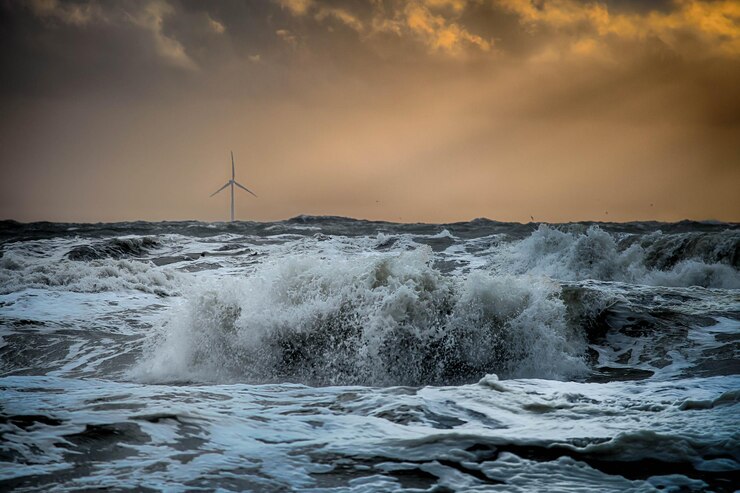The ocean, a vast and ever-moving expanse of water, holds immense potential. Beyond providing a habitat for countless species and serving as a vital regulatory force for our climate, the ocean’s motion hides a treasure trove of clean energy – wave energy.
This blog delves into the captivating world of wave energy, exploring its origins, the technology involved in harnessing its power, and its potential as a renewable energy source.
The Power of Motion: Understanding Waves
Have you ever stood mesmerized by the rhythmic crash of waves against the shore? The seemingly endless dance of the ocean hides a fascinating truth – waves are not actually water traveling across vast distances. Instead, they represent the transfer of energy through the water.
Wind, the primary driver of waves, transfers its kinetic energy to the water’s surface, creating ripples that travel outward. These ripples grow and morph into waves, their size and strength influenced by factors like wind speed, fetch (the distance over which the wind blows uninterrupted), and water depth.
As waves travel, water particles themselves don’t move great distances. Instead, they describe a circular motion in place, with the highest point of the circle corresponding to the wave crest. This transfer of energy continues until the wave reaches the shore, dissipating its power as it breaks or rolls gently onto the beach.
From Motion to Electricity: Capturing Wave Energy
The power harnessed from waves lies in their kinetic energy. Imagine the force of a crashing wave – that’s the raw potential waiting to be tapped into. Wave energy technology aims to capture this energy and convert it into electricity.
There are several approaches to achieving this, each with its own unique design and functioning:
- Oscillating Water Columns (OWCs): These devices consist of a partially submerged, hollow structure anchored to the seabed. As waves rise and fall, the water column within the OWC is forced up and down, pushing air through a turbine located at the top. The moving air in the turbine spins a shaft, converting the kinetic energy into electricity.
- Overtopping Devices: These capture waves by channeling them over a ramp-like structure. The captured water flows into a reservoir placed at a higher elevation. The weight of the elevated water then spins turbines located at a lower level, generating electricity.
- Point Absorbers: These floating devices bob up and down with the wave motion. Internal mechanisms within the absorber convert this vertical movement into electricity through hydraulic or mechanical processes.
- Wave Attenuators: These snake-like structures rest on the water’s surface, stretching along the wave’s direction. Segments of the attenuator rise and fall with the wave motion, and the resulting relative movement between segments is used to drive hydraulic pumps or electricity generators.
These represent just a few examples, and the field of wave energy technology is constantly evolving.
Advantages of Wave Energy
As a renewable energy source, wave energy offers several compelling advantages:
- Clean and Sustainable: Unlike fossil fuels, wave energy generation doesn’t produce harmful emissions, making it a clean and sustainable alternative.
- Predictable and Reliable: Waves are a consistent phenomenon, with predictable patterns based on wind and weather. While the intensity may vary, the overall wave resource is reliable compared to some renewable sources like solar or wind.
- High Energy Density: Waves pack a significant amount of energy. Even small waves can generate substantial electricity, making them a potent source of renewable power.
- Abundant Resource: Oceans cover a vast portion of the Earth’s surface, offering a virtually limitless potential for wave energy generation.
Challenges and Considerations
Despite its promise, wave energy also faces some challenges:
- Technology Development: Wave energy technology is still in its early stages compared to established sources like solar or wind. Further research and development are needed to improve efficiency and reduce costs.
- Environmental Impact: While generally considered environmentally friendly, wave energy devices can have some impact on marine life. Careful consideration and responsible placement are crucial to minimize these effects.
- Coastal Considerations: Deploying wave energy devices near coastlines can raise concerns about visual impact and potential interference with traditional maritime activities like fishing. Careful planning and community engagement are essential for successful implementation.
The Future of Wave Energy
Wave energy holds immense potential as a clean and reliable source of renewable energy. As technology advancements continue and costs decrease, wave energy is poised to play a significant role in the future of our energy mix.
Several countries, including Portugal, the United Kingdom, and Australia, are already making strides in developing and deploying wave energy projects. As research and development efforts continue, wave energy has the potential to become a major contributor to a sustainable energy future.
Here are some additional thoughts to ponder:
- Can wave energy be combined with other renewable sources like offshore wind to create hybrid power plants?

